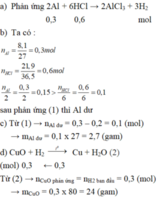Hãy nhập câu hỏi của bạn vào đây, nếu là tài khoản VIP, bạn sẽ được ưu tiên trả lời.

$a)$
$Mg+H_2SO_4\to MgSO_4+H_2$
$b)$
$n_{Mg}=\frac{2,4}{24}=0,1(mol)$
Theo PT: $n_{MgSO_4}=n_{Mg}=0,1(mol)$
$\to m_{MgSO_4}=0,1.120=12(g)$
$c)$
$CuO+H_2\xrightarrow{t^o}Cu+H_2O$
Theo PT: $n_{Cu}=n_{H_2}=n_{Mg}=0,1(mol)$
$\to m_{Cu}=0,1.64=6,4(g)$

a)\(n_{Mg}=\dfrac{35,6}{24}=1,483\left(mol\right)\)
\(V_{O2\left(đktc\right)}=\dfrac{21,504}{22,4}=0,96\left(mol\right)\)
pt: 2Mg + O2 → 2MgO (1)
mol: 2 1 2
mol:1,483 0,96
Tỉ lệ: \(\dfrac{1,483}{2}=0,7415< \dfrac{0,96}{1}=0,96\)
Mg tác dụng hết. O2 dư
theo PTHH có
\(n_{O2p\intư}=\dfrac{1,843x1}{2}=0,7415\left(mol\right)\)
nO2 dư=1,843-0,7415=1,1015 (mol)
mO2dư= 1,1015 x 32 = 35,48 (g)
b)theo PTHH có
\(n_{MgO}=\dfrac{1,843x2}{2}=1,843\left(mol\right)\)
nMgO = 1,843 X 40 = 73,72 (g)
c)
nMg PT(1)=nMgPT(2)=1,843 (mol)
pt: Mg + H2SO4 ➝ MgSO4 + H2 (2)
mol: 1 1 1 1
mol: 1,843
Theo PTHH có
\(n_{H2}=\dfrac{1,843x1}{1}=1,843\) (mol)
mH2=1,843 x 2 = 3,686 (g)

\(a) Mg + H_2SO_4 \to MgSO_4 + H_2\\ n_{Mg} = \dfrac{12}{24} = 0,5 < n_{H_2SO_4}= \dfrac{34,3}{98}=0,35\Rightarrow Mg\ dư\\ b) n_{MgSO_4} = n_{H_2SO_4} = 0,35(mol)\\ m_{MgSO_4} = 0,35.120 = 42(gam)\\ c) n_{H_2} = n_{H_2SO_4} = 0,35(mol)\Rightarrow V_{H_2} = 0,35.22,4 = 7,84(lít)\)

\(n_{Mg}=\dfrac{12}{24}=0,5\left(mol\right)\\
pthh:Mg+H_2SO_4\rightarrow MgSO_4+H_2\)
0,5 0,5 0,5
\(m_{MgSO_4}=0,5.120=60g\\
V_{H_2}=0,5.22,4=11,2\left(mol\right)\\
\)
c)
\(n_{H_2SO_4}=\dfrac{19,6}{98}=0,2\left(mol\right)\\
pthh:Zn+H_2SO_4\rightarrow ZnSO_4+H_2\\
LTL:0,5>0,2\)
=> H2SO4 dư
\(n_{Zn\left(p\text{ư}\right)}=n_{H_2SO_4}=0,2\left(mol\right)\\
n_{Zn\left(d\right)}=0,5-0,2=0,3\left(mol\right)\)

a,\(n_{Mg}=\dfrac{9,6}{24}=0,4\left(mol\right);n_{H_2SO_4}=1,5.0,2=0,3\left(mol\right)\)
PTHH: Mg + H2SO4 → MgSO4 + H2
Mol: 0,3 0,3 0,3
Ta có: \(\dfrac{0,4}{1}>\dfrac{0,3}{1}\) ⇒ Mg dư, H2SO4 pứ hết
\(m_{MgSO_4}=0,3.120=36\left(g\right)\)
b,\(V_{H_2}=0,3.22,4=6,72\left(l\right)\)
c, \(n_{Fe_2O_3}=\dfrac{6,4}{160}=0,04\left(mol\right)\)
PTHH: 3H2 + Fe2O3 → 2Fe + 3H2O
Mol: 0,04 0,08
Ta có: \(\dfrac{0,3}{3}>\dfrac{0,04}{1}\) ⇒ H2 dư, Fe2O3 pứ hết
\(\Rightarrow m_{Fe}=0,08.56=4,48\left(g\right)\)

a)
\(Mg + H_2SO_4 \to MgSO_4 + H_2\)
Magie tan dần, xuất hiện bọt khí không màu không mùi.
b)
\(n_{H_2} = n_{MgSO_4} = n_{Mg} = \dfrac{9,6}{24} = 0,4(mol)\\ m_{MgSO_4} = 0,4.120 = 48(gam)\\ V_{H_2} = 0,4.22,4 = 8,96(lít)\)
c)
\(CuO + H_2 \xrightarrow{t^o} Cu + H_2O\\ n_{Cu} = n_{H_2} = 0,4(mol)\\ \Rightarrow m_{Cu} = 0,4.64 = 25,6(gam)\)

\(n_{Mg}=\dfrac{13}{24}=0,54mol\)
\(Mg+2HCl\rightarrow MgCl_2+H_2\)
0,54 0,54 ( mol )
\(m_{MgCl_2}=0,54.95=51,3g\)
\(CuO+H_2\rightarrow\left(t^o\right)Cu+H_2O\)
0,54 0,54 ( mol )
\(m_{Cu}=0,54.64=34,56g\)

a)
\(Mg + H_2SO_4 \to MgSO_4 + H_2\\ n_{H_2} = n_{Mg} = \dfrac{3,6}{24} = 0,15(mol)\\ b)\\ CuO + H_2 \xrightarrow{t^o} Cu + H_2O\\ n_{Cu} = n_{H_2} = 0,15(mol)\\ \Rightarrow m_{Cu} = 0,15.64 = 9,6(gam)\)

\(n_{Mg}=\dfrac{2,4}{24}=0,1\left(mol\right)\\ pthh:Mg+H_2SO_4\rightarrow MgSO_4+H_2\)
0,1 0,1 0,1
\(m_{MgSO_4}=120.0,1=12\left(g\right)\\ n_{CuO}=\dfrac{48}{80}=0,6\left(mol\right)\\ pthh:CuO+H_2\underrightarrow{t^o}Cu+H_2O\)
\(LTL:\dfrac{0,6}{1}>\dfrac{0,1}{1}\)
=> CuO dư
\(n_{CuO\left(P\text{Ư}\right)}=n_{H_2}=0,1\left(mol\right)\\ m_{CuO\left(d\right)}=\left(0,6-0,1\right).80=40\left(g\right)\)
nMg=2,424=0,1(mol)pthh:Mg+H2SO4→MgSO4+H2nMg=2,424=0,1(mol)pthh:Mg+H2SO4→MgSO4+H2
0,1 0,1 0,1
mMgSO4=120.0,1=12(g)nCuO=4880=0,6(mol)pthh:CuO+H2to→Cu+H2OmMgSO4=120.0,1=12(g)nCuO=4880=0,6(mol)pthh:CuO+H2to→Cu+H2O